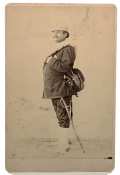site search
online catalog
CABINET CARD PHOTO OF US NAVY SPANISH AMERICAN WAR OFFICER ATTIRED FOR CAMPAIGN SERVICE ON LAND- WILLIAM H. SCHUETZE- HE OPENED THE BATTLE OF SANTIAGO

$395.00
Quantity Available: 1
Item Code: 1219-46
Shipping: Determined by Method & Location of buyer
To Order:
Call 717-334-0347,
Fax 717-334-5016, or E-mail
This is a very nicely posed Spanish-American War period cabinet card photograph backmarked by a New York photographer showing a slightly portly US Navy officer dressed for service with a landing party. His US Navy officer’s sword hangs at his side and he has a holstered revolver on his hip. He has a blanket roll over one shoulder and a US Spanish American War style canteen slung over the other. The canteen rests on a canvas haversack, on which he has tied his officer’s cap, donning a white pith helmet instead, and wearing a pair of white gaiters, no doubt to cope with hot weather and undergrowth in Cuba or the Philippines. He has tucked his hand beneath the blanket roll on this chest to show off all his gear.
He is identified on the back of the card as “Capt. Shutze.” The only candidate we find is William H. Schuetze (1853-1902) who, so far as we know, only rose to Lieutenant Commander, but gained a certain amount of fame- the mistake of an admirer in his rank is certainly no greater than the spelling of his name.
Schuetze was made midshipman in 1869 and graduated Annapolis in 1873. He was very well respected by fellow officers and was the subject of a memorial volume published after his death. Two of his achievements were made in very different climates. In the 1880s he was part of an expedition to Siberia to clarify the fate of members of the Jeanette Expedition, the US Arctic Expedition of 1879-1881, only thirteen of whom had survived out of thirty-three when the ship was trapped by ice. In 1898 he was Navigator on the battleship USS Iowa, and apparently at the helm when the Spanish attempted a breakout from the harbor of Santiago de Cuba on July 3, 1898, firing the first gun in a battle that destroyed the Spanish fleet.
A fellow officer wrote in a letter, quoted in the memorial volume, “And so , my dear Deering , he who would not wish to be a hero at forty - five , one William H. Schuetze , was one up to the neck in fine and sufficient shape. He it was who first made out the Spaniards advancing , and jammed the indicators full speed ahead, and rang general - quarters , fired the first gun , and did all the things that heroes, as a race , are wont to do under like conditions and environments. . .”
Schuetze may have made a good compromise hero for the battle: Admirals Sampson and Schley were in an unpleasant public competition for the battle honors. Schuetze was also memorialized by a fellow officer with the placement of a statue titled “Serenity” in a Washington, D.C. park, which is remarkable in its own right. We have not found this view published elsewhere, but the figure bears a strong resemblance to some later portraits and we think this identification is likely correct. [sr][ph:m/L]
~~~~~~~~~~~~~~~~~~~~~~~~~~~~~~~~~~~
THIS ITEM, AS WITH ALL OTHER ITEMS AVAILABLE ON OUR WEB SITE,
MAY BE PURCHASED THROUGH OUR LAYAWAY PROGRAM.
CLICK HERE FOR OUR POLICIES AND TERMS.
THANK YOU!
Inquire About CABINET CARD PHOTO OF US NAVY SPANISH AMERICAN WAR OFFICER ATTIRED FOR CAMPAIGN SERVICE ON LAND- WILLIAM H. SCHUETZE- HE OPENED THE BATTLE OF SANTIAGO
For inquiries, please email us at [email protected]
Most Popular
Historical Firearms Stolen From The National Civil War Museum In Harrisburg, Pa »
Theft From Gravesite Of Gen. John Reynolds »
Selection Of Unframed Prints By Don Troiani »
Fine Condition Brass Infantry Bugle Insignia »
British Imported, Confederate Used Bayonet »
Scarce New Model 1865 Sharps Still In Percussion Near Factory New »
featured item
WOUNDED AT GETTYSBURG! 1/6 PLATE AMBROTYPE OF PVT. AURELIUS JAMES DULA, 22ND NORTH CAROLINA
Sixth plate hand-gilt ambrotype. Leatherette case. Anonymous artist. North Carolina. Private Aurelius James “A.J.” Dula (1843 - 1913), a member of Company A (the "Caldwell Rough and Ready Boys”) of the 22nd North Carolina Infantry. A native… (846-577). Learn More »
site search
Upcoming Events
May 16 - 18: N-SSA Spring Nationals, Fort Shenandoah, Winchester, VA Learn More »






